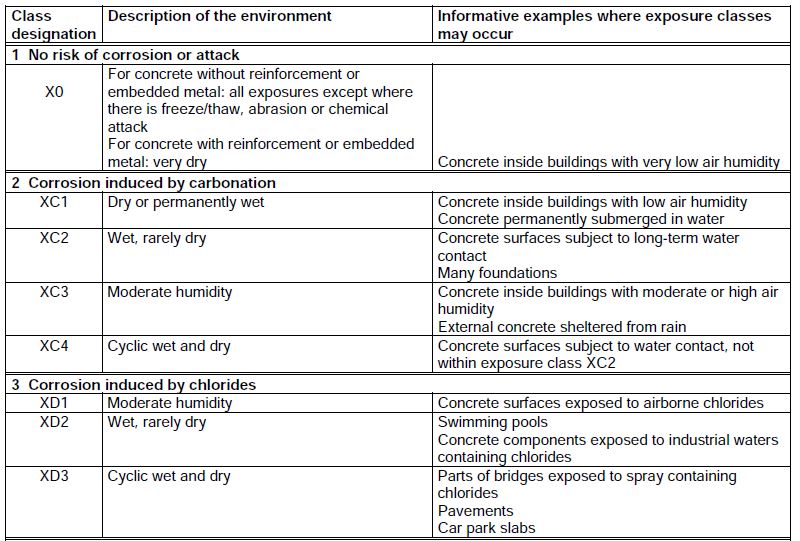According to Eurocode 2, anti-corrosion protection depends on the nominal coverage of the reinforcement and the formation of cracks in the concrete.
In addition, the density of the concrete, the water-cement ratio, the strength class, etc. can be considered as other factors related to the durability of concrete. Environmental conditions are the starting factor in selecting the nominal reinforcement efficiency.
Exposure classes based on environmental conditions are grouped into six main categories in Eurocode 2. They are as follows:
- No risk of corrosion or attack
- Corrosion due to carbonation
- Chloride corrosion
- Corrosion caused by chlorides in seawater
- Freeze/Thaw Attack
- Chemical attack
Within each main category there are subcategories depending on changes in the environment. There are separate articles on this site that Carbonation Chloride corrosion, Chemical attacks AND Free/thaw attacks The following Eurodoe 2 table indicates all exposure classes that must be taken into account when selecting reinforcement cover.




To determine the nominal coverage of the reinforcement, two main components must be calculated.
C Last name =C Minimum +ΔC developer
Where
C Minimum – a minimum concrete cover calculated based on three main factors.
- Minimum coverage requirement when gluing reinforcements
- Minimum durability coverage requirement for reinforcements
ΔC developer – Consideration of project deviations
Minimum coverage requirement when gluing reinforcements
The minimum coverage in relation to the stiffening stress of the reinforcement is found in Table 4.2 of EN 1992-1-1:2004. It is recommended to specify at least one bar diameter for a single bar and a corresponding bar diameter for grouped bars. More information can be found in Eurocode 2.
Minimum coverage requirement for reinforcement durability
Firstly, structures need to be classified based on environmental conditions, structural class, construction aspects, etc., as the reinforcement coverage in terms of durability is determined based on the structural class. Eurocode provides a guideline for selecting a structural class that should be taken into account when determining reinforcement coverage. It proposes increasing/decreasing the structure class based on the various operational aspects listed in the table below.


After selecting the structural class to take into account in each individual case and based on the exposure class to which the structure is exposed, the minimum reinforcement coverage can be consulted in the following Eurocode 2 table. The classification of structures is discussed in another article: Structural class according to Eurocode ” published on this site.


The minimum coverage of reinforcing bars based on durability requirements can be found in the table above. Armor coverage depends on the type of structure and its durability.
In addition, there are other factors, such as fire resistance, that are taken into account when evaluating rebar coverage. The use of different materials and additional protection requirements, etc. are also taken into consideration when determining the required reinforcement coverage. To calculate the reinforcement cover, the following equation is specified in EC2.
C Minimum = Max{ C min,b ; C min, duration +ΔC major, γ –ΔC headquarters –ΔC main, add ; 10}
Tolerance of design deviations
Reinforcement coverage deviation can be negative or positive. However, the nominal coverage of the reinforcement must be increased by the absolute value of the deviation. Changes to the reinforcement cover during the construction phase, e.g. B. Reinforcement covering on uneven surfaces may require a certain tolerance for deviations.
Taking into account all the above facts, the nominal coverage of the reinforcement can be calculated. There are other factors that affect the durability of concrete and will be discussed in another article.

